Influences of Culture, Power and Politics on Individual and Team Performance
VerifiedAdded on 2023/02/02
|12
|3704
|85
AI Summary
This study report explains the influences of culture, power, and politics on individual and team performance in an organization. It also discusses various content and process theories of motivation and philosophies of organizational behavior.
Contribute Materials
Your contribution can guide someone’s learning journey. Share your
documents today.

ORGANISATIONAL
BEHAVIOUR
BEHAVIOUR
Secure Best Marks with AI Grader
Need help grading? Try our AI Grader for instant feedback on your assignments.
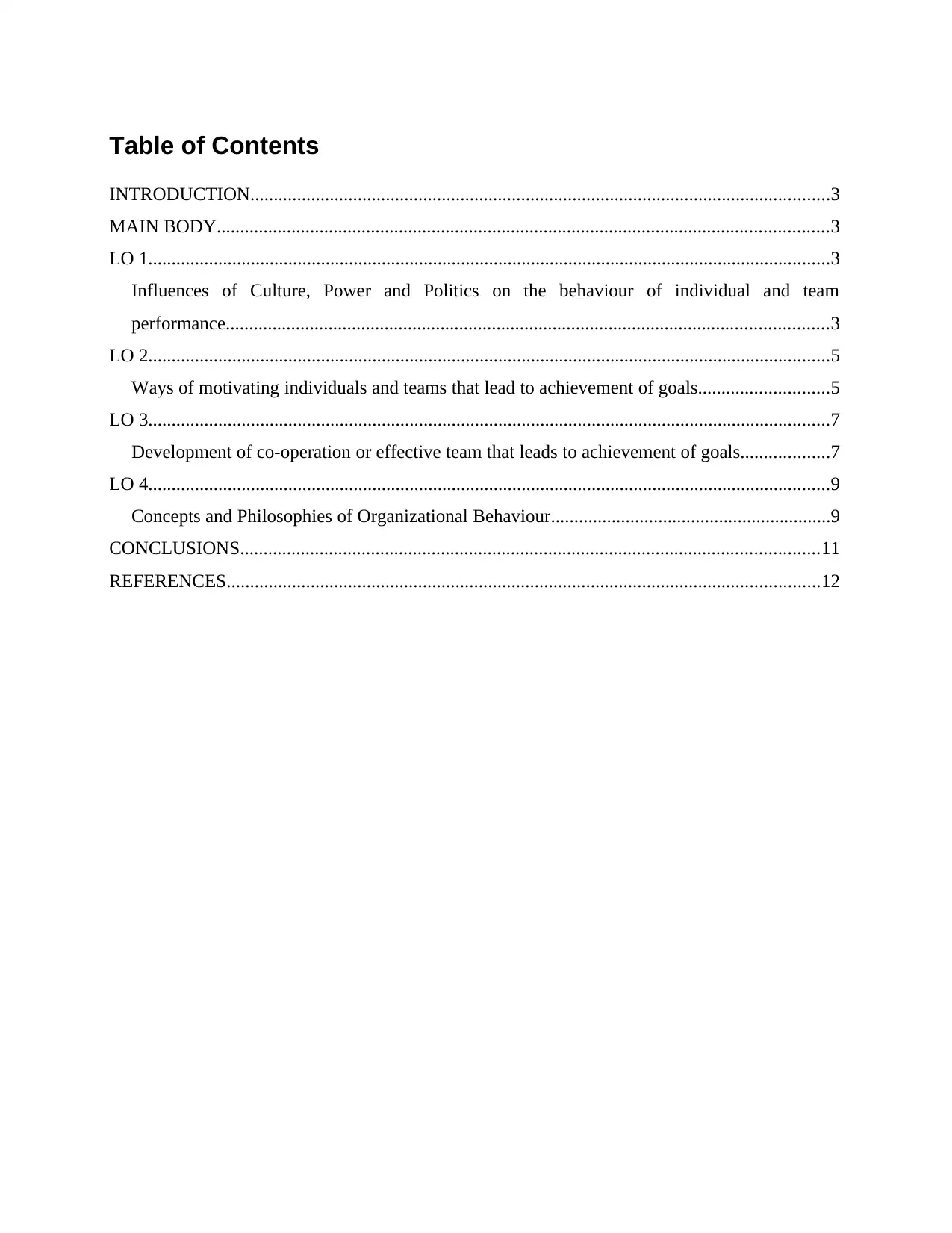
Table of Contents
INTRODUCTION............................................................................................................................3
MAIN BODY...................................................................................................................................3
LO 1..................................................................................................................................................3
Influences of Culture, Power and Politics on the behaviour of individual and team
performance.................................................................................................................................3
LO 2..................................................................................................................................................5
Ways of motivating individuals and teams that lead to achievement of goals............................5
LO 3..................................................................................................................................................7
Development of co-operation or effective team that leads to achievement of goals...................7
LO 4..................................................................................................................................................9
Concepts and Philosophies of Organizational Behaviour............................................................9
CONCLUSIONS............................................................................................................................11
REFERENCES...............................................................................................................................12
INTRODUCTION............................................................................................................................3
MAIN BODY...................................................................................................................................3
LO 1..................................................................................................................................................3
Influences of Culture, Power and Politics on the behaviour of individual and team
performance.................................................................................................................................3
LO 2..................................................................................................................................................5
Ways of motivating individuals and teams that lead to achievement of goals............................5
LO 3..................................................................................................................................................7
Development of co-operation or effective team that leads to achievement of goals...................7
LO 4..................................................................................................................................................9
Concepts and Philosophies of Organizational Behaviour............................................................9
CONCLUSIONS............................................................................................................................11
REFERENCES...............................................................................................................................12
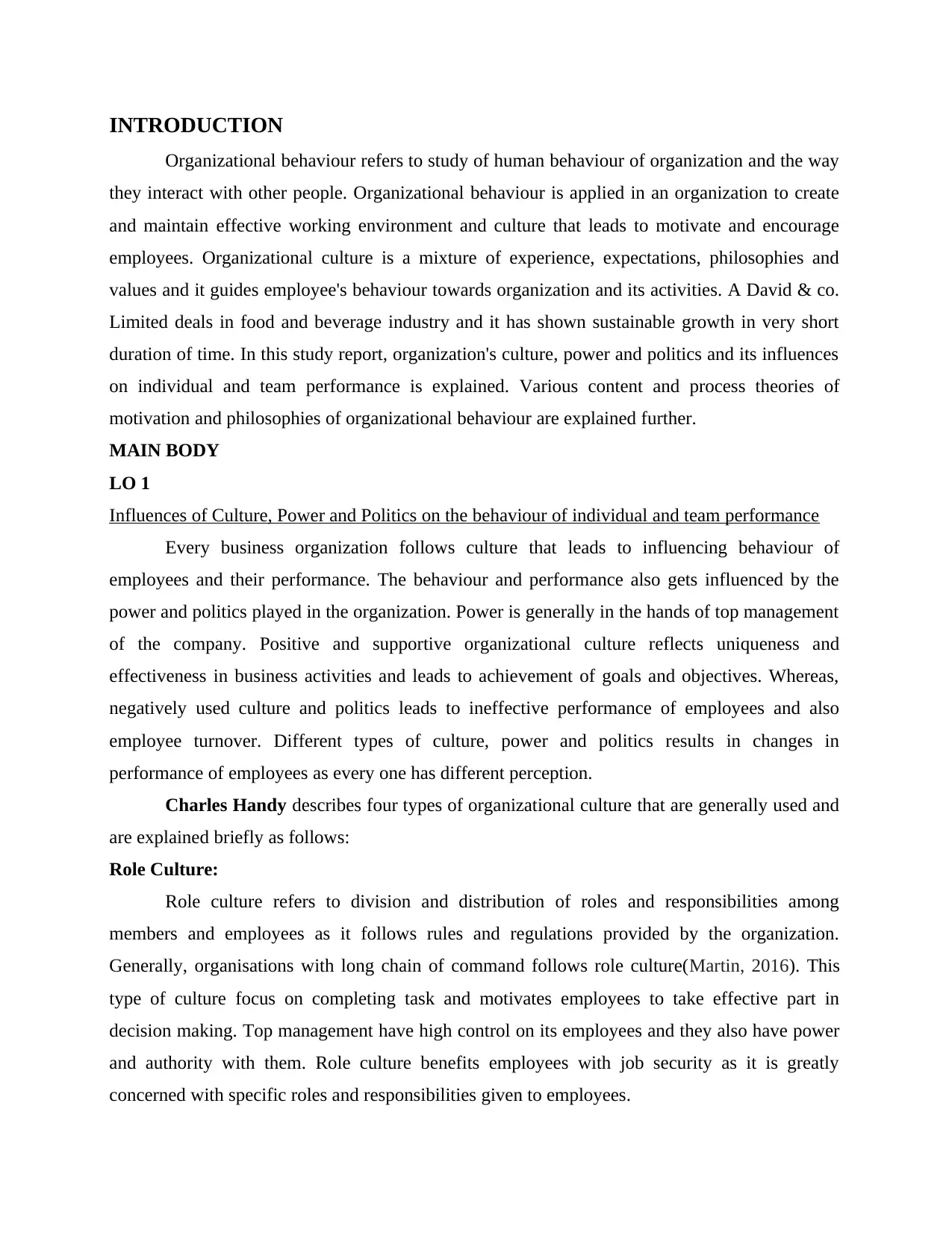
INTRODUCTION
Organizational behaviour refers to study of human behaviour of organization and the way
they interact with other people. Organizational behaviour is applied in an organization to create
and maintain effective working environment and culture that leads to motivate and encourage
employees. Organizational culture is a mixture of experience, expectations, philosophies and
values and it guides employee's behaviour towards organization and its activities. A David & co.
Limited deals in food and beverage industry and it has shown sustainable growth in very short
duration of time. In this study report, organization's culture, power and politics and its influences
on individual and team performance is explained. Various content and process theories of
motivation and philosophies of organizational behaviour are explained further.
MAIN BODY
LO 1
Influences of Culture, Power and Politics on the behaviour of individual and team performance
Every business organization follows culture that leads to influencing behaviour of
employees and their performance. The behaviour and performance also gets influenced by the
power and politics played in the organization. Power is generally in the hands of top management
of the company. Positive and supportive organizational culture reflects uniqueness and
effectiveness in business activities and leads to achievement of goals and objectives. Whereas,
negatively used culture and politics leads to ineffective performance of employees and also
employee turnover. Different types of culture, power and politics results in changes in
performance of employees as every one has different perception.
Charles Handy describes four types of organizational culture that are generally used and
are explained briefly as follows:
Role Culture:
Role culture refers to division and distribution of roles and responsibilities among
members and employees as it follows rules and regulations provided by the organization.
Generally, organisations with long chain of command follows role culture(Martin, 2016). This
type of culture focus on completing task and motivates employees to take effective part in
decision making. Top management have high control on its employees and they also have power
and authority with them. Role culture benefits employees with job security as it is greatly
concerned with specific roles and responsibilities given to employees.
Organizational behaviour refers to study of human behaviour of organization and the way
they interact with other people. Organizational behaviour is applied in an organization to create
and maintain effective working environment and culture that leads to motivate and encourage
employees. Organizational culture is a mixture of experience, expectations, philosophies and
values and it guides employee's behaviour towards organization and its activities. A David & co.
Limited deals in food and beverage industry and it has shown sustainable growth in very short
duration of time. In this study report, organization's culture, power and politics and its influences
on individual and team performance is explained. Various content and process theories of
motivation and philosophies of organizational behaviour are explained further.
MAIN BODY
LO 1
Influences of Culture, Power and Politics on the behaviour of individual and team performance
Every business organization follows culture that leads to influencing behaviour of
employees and their performance. The behaviour and performance also gets influenced by the
power and politics played in the organization. Power is generally in the hands of top management
of the company. Positive and supportive organizational culture reflects uniqueness and
effectiveness in business activities and leads to achievement of goals and objectives. Whereas,
negatively used culture and politics leads to ineffective performance of employees and also
employee turnover. Different types of culture, power and politics results in changes in
performance of employees as every one has different perception.
Charles Handy describes four types of organizational culture that are generally used and
are explained briefly as follows:
Role Culture:
Role culture refers to division and distribution of roles and responsibilities among
members and employees as it follows rules and regulations provided by the organization.
Generally, organisations with long chain of command follows role culture(Martin, 2016). This
type of culture focus on completing task and motivates employees to take effective part in
decision making. Top management have high control on its employees and they also have power
and authority with them. Role culture benefits employees with job security as it is greatly
concerned with specific roles and responsibilities given to employees.
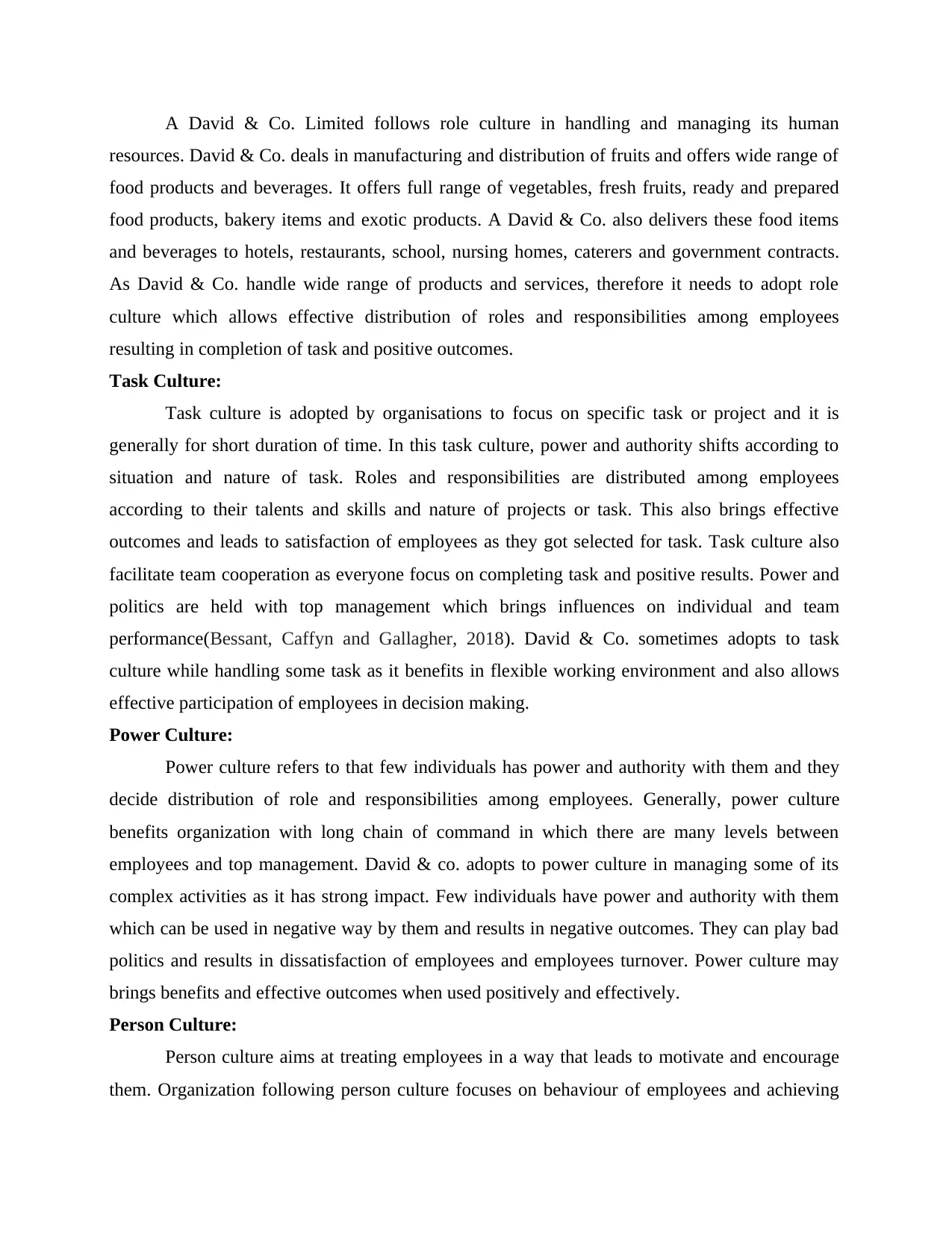
A David & Co. Limited follows role culture in handling and managing its human
resources. David & Co. deals in manufacturing and distribution of fruits and offers wide range of
food products and beverages. It offers full range of vegetables, fresh fruits, ready and prepared
food products, bakery items and exotic products. A David & Co. also delivers these food items
and beverages to hotels, restaurants, school, nursing homes, caterers and government contracts.
As David & Co. handle wide range of products and services, therefore it needs to adopt role
culture which allows effective distribution of roles and responsibilities among employees
resulting in completion of task and positive outcomes.
Task Culture:
Task culture is adopted by organisations to focus on specific task or project and it is
generally for short duration of time. In this task culture, power and authority shifts according to
situation and nature of task. Roles and responsibilities are distributed among employees
according to their talents and skills and nature of projects or task. This also brings effective
outcomes and leads to satisfaction of employees as they got selected for task. Task culture also
facilitate team cooperation as everyone focus on completing task and positive results. Power and
politics are held with top management which brings influences on individual and team
performance(Bessant, Caffyn and Gallagher, 2018). David & Co. sometimes adopts to task
culture while handling some task as it benefits in flexible working environment and also allows
effective participation of employees in decision making.
Power Culture:
Power culture refers to that few individuals has power and authority with them and they
decide distribution of role and responsibilities among employees. Generally, power culture
benefits organization with long chain of command in which there are many levels between
employees and top management. David & co. adopts to power culture in managing some of its
complex activities as it has strong impact. Few individuals have power and authority with them
which can be used in negative way by them and results in negative outcomes. They can play bad
politics and results in dissatisfaction of employees and employees turnover. Power culture may
brings benefits and effective outcomes when used positively and effectively.
Person Culture:
Person culture aims at treating employees in a way that leads to motivate and encourage
them. Organization following person culture focuses on behaviour of employees and achieving
resources. David & Co. deals in manufacturing and distribution of fruits and offers wide range of
food products and beverages. It offers full range of vegetables, fresh fruits, ready and prepared
food products, bakery items and exotic products. A David & Co. also delivers these food items
and beverages to hotels, restaurants, school, nursing homes, caterers and government contracts.
As David & Co. handle wide range of products and services, therefore it needs to adopt role
culture which allows effective distribution of roles and responsibilities among employees
resulting in completion of task and positive outcomes.
Task Culture:
Task culture is adopted by organisations to focus on specific task or project and it is
generally for short duration of time. In this task culture, power and authority shifts according to
situation and nature of task. Roles and responsibilities are distributed among employees
according to their talents and skills and nature of projects or task. This also brings effective
outcomes and leads to satisfaction of employees as they got selected for task. Task culture also
facilitate team cooperation as everyone focus on completing task and positive results. Power and
politics are held with top management which brings influences on individual and team
performance(Bessant, Caffyn and Gallagher, 2018). David & Co. sometimes adopts to task
culture while handling some task as it benefits in flexible working environment and also allows
effective participation of employees in decision making.
Power Culture:
Power culture refers to that few individuals has power and authority with them and they
decide distribution of role and responsibilities among employees. Generally, power culture
benefits organization with long chain of command in which there are many levels between
employees and top management. David & co. adopts to power culture in managing some of its
complex activities as it has strong impact. Few individuals have power and authority with them
which can be used in negative way by them and results in negative outcomes. They can play bad
politics and results in dissatisfaction of employees and employees turnover. Power culture may
brings benefits and effective outcomes when used positively and effectively.
Person Culture:
Person culture aims at treating employees in a way that leads to motivate and encourage
them. Organization following person culture focuses on behaviour of employees and achieving
Secure Best Marks with AI Grader
Need help grading? Try our AI Grader for instant feedback on your assignments.
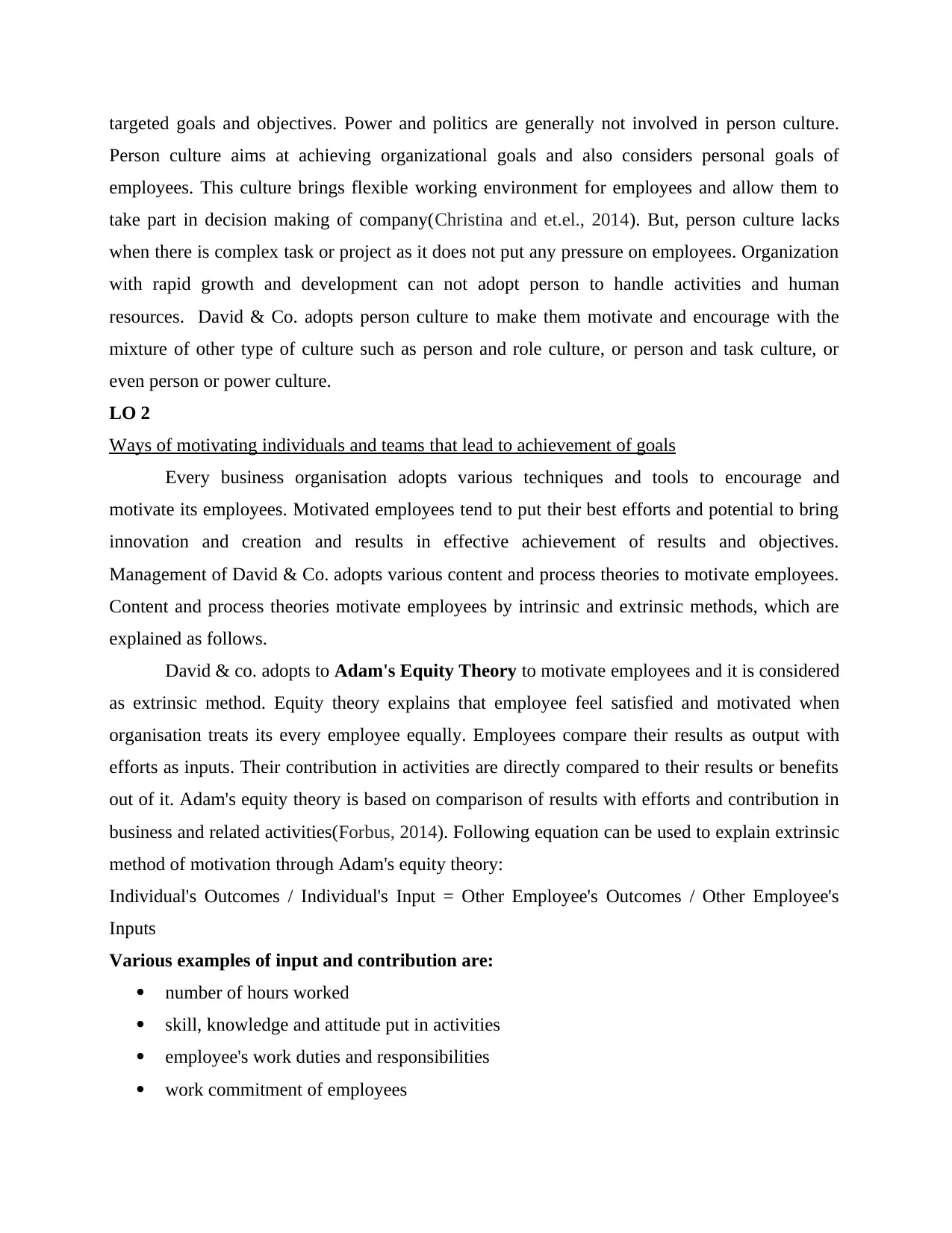
targeted goals and objectives. Power and politics are generally not involved in person culture.
Person culture aims at achieving organizational goals and also considers personal goals of
employees. This culture brings flexible working environment for employees and allow them to
take part in decision making of company(Christina and et.el., 2014). But, person culture lacks
when there is complex task or project as it does not put any pressure on employees. Organization
with rapid growth and development can not adopt person to handle activities and human
resources. David & Co. adopts person culture to make them motivate and encourage with the
mixture of other type of culture such as person and role culture, or person and task culture, or
even person or power culture.
LO 2
Ways of motivating individuals and teams that lead to achievement of goals
Every business organisation adopts various techniques and tools to encourage and
motivate its employees. Motivated employees tend to put their best efforts and potential to bring
innovation and creation and results in effective achievement of results and objectives.
Management of David & Co. adopts various content and process theories to motivate employees.
Content and process theories motivate employees by intrinsic and extrinsic methods, which are
explained as follows.
David & co. adopts to Adam's Equity Theory to motivate employees and it is considered
as extrinsic method. Equity theory explains that employee feel satisfied and motivated when
organisation treats its every employee equally. Employees compare their results as output with
efforts as inputs. Their contribution in activities are directly compared to their results or benefits
out of it. Adam's equity theory is based on comparison of results with efforts and contribution in
business and related activities(Forbus, 2014). Following equation can be used to explain extrinsic
method of motivation through Adam's equity theory:
Individual's Outcomes / Individual's Input = Other Employee's Outcomes / Other Employee's
Inputs
Various examples of input and contribution are:
number of hours worked
skill, knowledge and attitude put in activities
employee's work duties and responsibilities
work commitment of employees
Person culture aims at achieving organizational goals and also considers personal goals of
employees. This culture brings flexible working environment for employees and allow them to
take part in decision making of company(Christina and et.el., 2014). But, person culture lacks
when there is complex task or project as it does not put any pressure on employees. Organization
with rapid growth and development can not adopt person to handle activities and human
resources. David & Co. adopts person culture to make them motivate and encourage with the
mixture of other type of culture such as person and role culture, or person and task culture, or
even person or power culture.
LO 2
Ways of motivating individuals and teams that lead to achievement of goals
Every business organisation adopts various techniques and tools to encourage and
motivate its employees. Motivated employees tend to put their best efforts and potential to bring
innovation and creation and results in effective achievement of results and objectives.
Management of David & Co. adopts various content and process theories to motivate employees.
Content and process theories motivate employees by intrinsic and extrinsic methods, which are
explained as follows.
David & co. adopts to Adam's Equity Theory to motivate employees and it is considered
as extrinsic method. Equity theory explains that employee feel satisfied and motivated when
organisation treats its every employee equally. Employees compare their results as output with
efforts as inputs. Their contribution in activities are directly compared to their results or benefits
out of it. Adam's equity theory is based on comparison of results with efforts and contribution in
business and related activities(Forbus, 2014). Following equation can be used to explain extrinsic
method of motivation through Adam's equity theory:
Individual's Outcomes / Individual's Input = Other Employee's Outcomes / Other Employee's
Inputs
Various examples of input and contribution are:
number of hours worked
skill, knowledge and attitude put in activities
employee's work duties and responsibilities
work commitment of employees
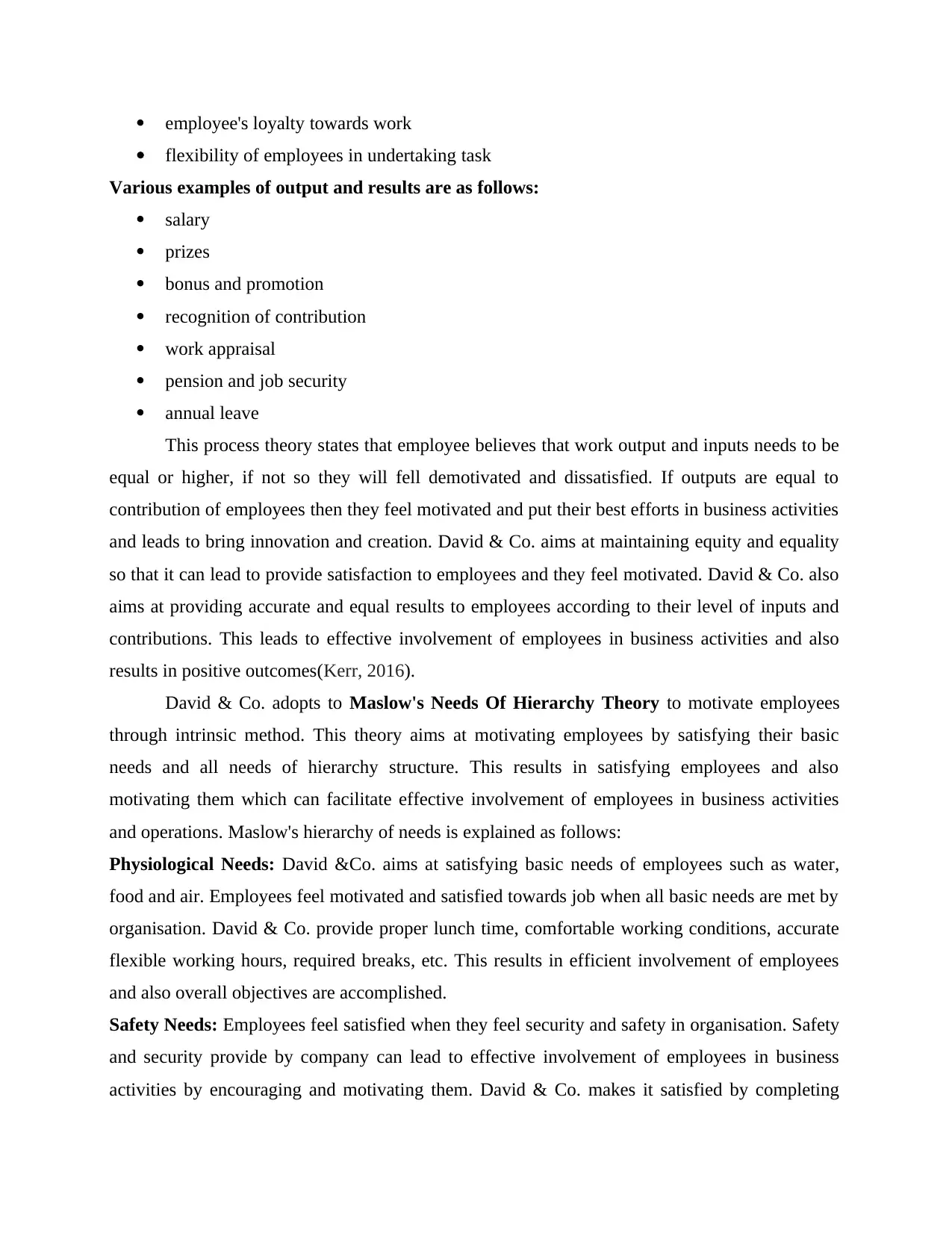
employee's loyalty towards work
flexibility of employees in undertaking task
Various examples of output and results are as follows:
salary
prizes
bonus and promotion
recognition of contribution
work appraisal
pension and job security
annual leave
This process theory states that employee believes that work output and inputs needs to be
equal or higher, if not so they will fell demotivated and dissatisfied. If outputs are equal to
contribution of employees then they feel motivated and put their best efforts in business activities
and leads to bring innovation and creation. David & Co. aims at maintaining equity and equality
so that it can lead to provide satisfaction to employees and they feel motivated. David & Co. also
aims at providing accurate and equal results to employees according to their level of inputs and
contributions. This leads to effective involvement of employees in business activities and also
results in positive outcomes(Kerr, 2016).
David & Co. adopts to Maslow's Needs Of Hierarchy Theory to motivate employees
through intrinsic method. This theory aims at motivating employees by satisfying their basic
needs and all needs of hierarchy structure. This results in satisfying employees and also
motivating them which can facilitate effective involvement of employees in business activities
and operations. Maslow's hierarchy of needs is explained as follows:
Physiological Needs: David &Co. aims at satisfying basic needs of employees such as water,
food and air. Employees feel motivated and satisfied towards job when all basic needs are met by
organisation. David & Co. provide proper lunch time, comfortable working conditions, accurate
flexible working hours, required breaks, etc. This results in efficient involvement of employees
and also overall objectives are accomplished.
Safety Needs: Employees feel satisfied when they feel security and safety in organisation. Safety
and security provide by company can lead to effective involvement of employees in business
activities by encouraging and motivating them. David & Co. makes it satisfied by completing
flexibility of employees in undertaking task
Various examples of output and results are as follows:
salary
prizes
bonus and promotion
recognition of contribution
work appraisal
pension and job security
annual leave
This process theory states that employee believes that work output and inputs needs to be
equal or higher, if not so they will fell demotivated and dissatisfied. If outputs are equal to
contribution of employees then they feel motivated and put their best efforts in business activities
and leads to bring innovation and creation. David & Co. aims at maintaining equity and equality
so that it can lead to provide satisfaction to employees and they feel motivated. David & Co. also
aims at providing accurate and equal results to employees according to their level of inputs and
contributions. This leads to effective involvement of employees in business activities and also
results in positive outcomes(Kerr, 2016).
David & Co. adopts to Maslow's Needs Of Hierarchy Theory to motivate employees
through intrinsic method. This theory aims at motivating employees by satisfying their basic
needs and all needs of hierarchy structure. This results in satisfying employees and also
motivating them which can facilitate effective involvement of employees in business activities
and operations. Maslow's hierarchy of needs is explained as follows:
Physiological Needs: David &Co. aims at satisfying basic needs of employees such as water,
food and air. Employees feel motivated and satisfied towards job when all basic needs are met by
organisation. David & Co. provide proper lunch time, comfortable working conditions, accurate
flexible working hours, required breaks, etc. This results in efficient involvement of employees
and also overall objectives are accomplished.
Safety Needs: Employees feel satisfied when they feel security and safety in organisation. Safety
and security provide by company can lead to effective involvement of employees in business
activities by encouraging and motivating them. David & Co. makes it satisfied by completing
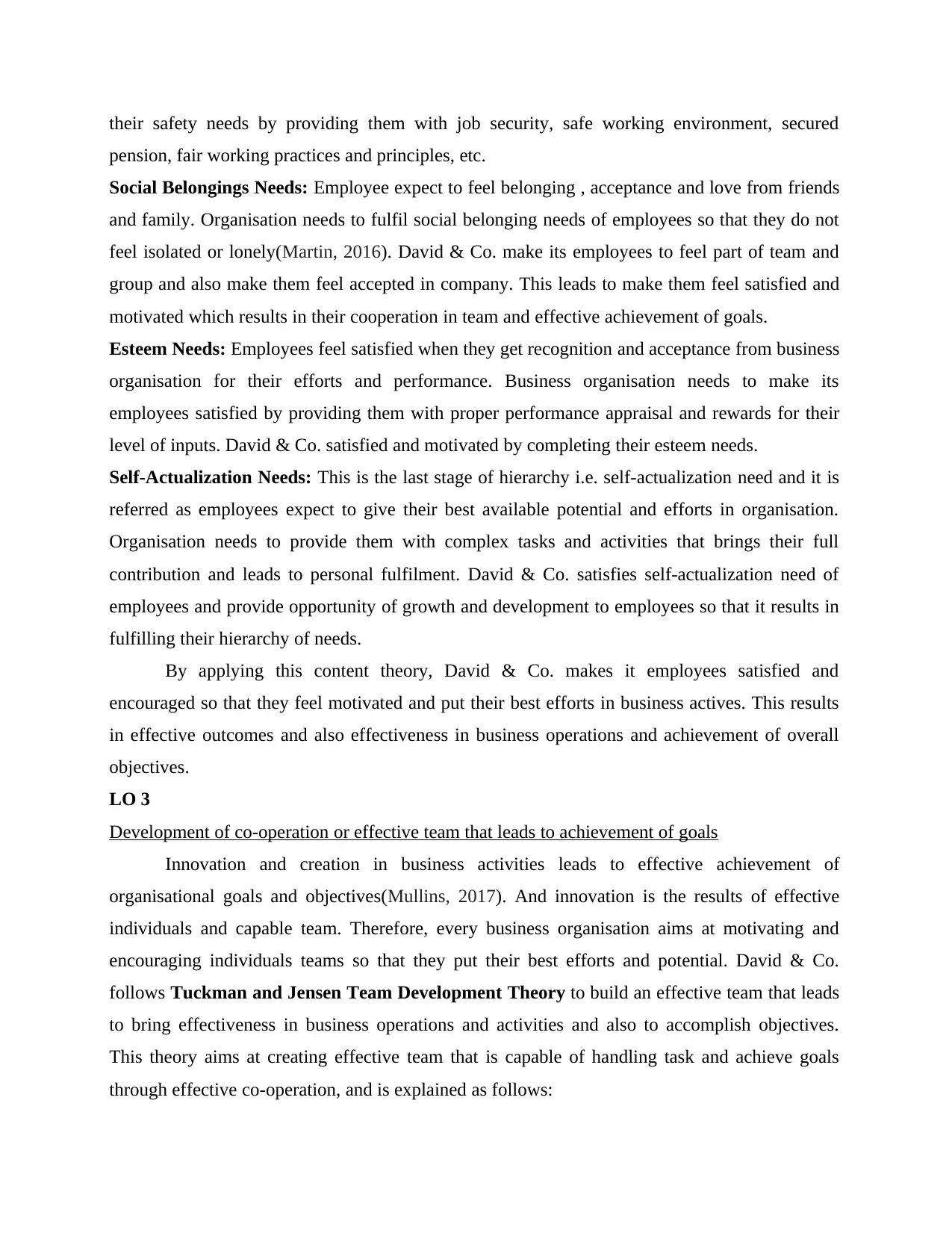
their safety needs by providing them with job security, safe working environment, secured
pension, fair working practices and principles, etc.
Social Belongings Needs: Employee expect to feel belonging , acceptance and love from friends
and family. Organisation needs to fulfil social belonging needs of employees so that they do not
feel isolated or lonely(Martin, 2016). David & Co. make its employees to feel part of team and
group and also make them feel accepted in company. This leads to make them feel satisfied and
motivated which results in their cooperation in team and effective achievement of goals.
Esteem Needs: Employees feel satisfied when they get recognition and acceptance from business
organisation for their efforts and performance. Business organisation needs to make its
employees satisfied by providing them with proper performance appraisal and rewards for their
level of inputs. David & Co. satisfied and motivated by completing their esteem needs.
Self-Actualization Needs: This is the last stage of hierarchy i.e. self-actualization need and it is
referred as employees expect to give their best available potential and efforts in organisation.
Organisation needs to provide them with complex tasks and activities that brings their full
contribution and leads to personal fulfilment. David & Co. satisfies self-actualization need of
employees and provide opportunity of growth and development to employees so that it results in
fulfilling their hierarchy of needs.
By applying this content theory, David & Co. makes it employees satisfied and
encouraged so that they feel motivated and put their best efforts in business actives. This results
in effective outcomes and also effectiveness in business operations and achievement of overall
objectives.
LO 3
Development of co-operation or effective team that leads to achievement of goals
Innovation and creation in business activities leads to effective achievement of
organisational goals and objectives(Mullins, 2017). And innovation is the results of effective
individuals and capable team. Therefore, every business organisation aims at motivating and
encouraging individuals teams so that they put their best efforts and potential. David & Co.
follows Tuckman and Jensen Team Development Theory to build an effective team that leads
to bring effectiveness in business operations and activities and also to accomplish objectives.
This theory aims at creating effective team that is capable of handling task and achieve goals
through effective co-operation, and is explained as follows:
pension, fair working practices and principles, etc.
Social Belongings Needs: Employee expect to feel belonging , acceptance and love from friends
and family. Organisation needs to fulfil social belonging needs of employees so that they do not
feel isolated or lonely(Martin, 2016). David & Co. make its employees to feel part of team and
group and also make them feel accepted in company. This leads to make them feel satisfied and
motivated which results in their cooperation in team and effective achievement of goals.
Esteem Needs: Employees feel satisfied when they get recognition and acceptance from business
organisation for their efforts and performance. Business organisation needs to make its
employees satisfied by providing them with proper performance appraisal and rewards for their
level of inputs. David & Co. satisfied and motivated by completing their esteem needs.
Self-Actualization Needs: This is the last stage of hierarchy i.e. self-actualization need and it is
referred as employees expect to give their best available potential and efforts in organisation.
Organisation needs to provide them with complex tasks and activities that brings their full
contribution and leads to personal fulfilment. David & Co. satisfies self-actualization need of
employees and provide opportunity of growth and development to employees so that it results in
fulfilling their hierarchy of needs.
By applying this content theory, David & Co. makes it employees satisfied and
encouraged so that they feel motivated and put their best efforts in business actives. This results
in effective outcomes and also effectiveness in business operations and achievement of overall
objectives.
LO 3
Development of co-operation or effective team that leads to achievement of goals
Innovation and creation in business activities leads to effective achievement of
organisational goals and objectives(Mullins, 2017). And innovation is the results of effective
individuals and capable team. Therefore, every business organisation aims at motivating and
encouraging individuals teams so that they put their best efforts and potential. David & Co.
follows Tuckman and Jensen Team Development Theory to build an effective team that leads
to bring effectiveness in business operations and activities and also to accomplish objectives.
This theory aims at creating effective team that is capable of handling task and achieve goals
through effective co-operation, and is explained as follows:
Paraphrase This Document
Need a fresh take? Get an instant paraphrase of this document with our AI Paraphraser
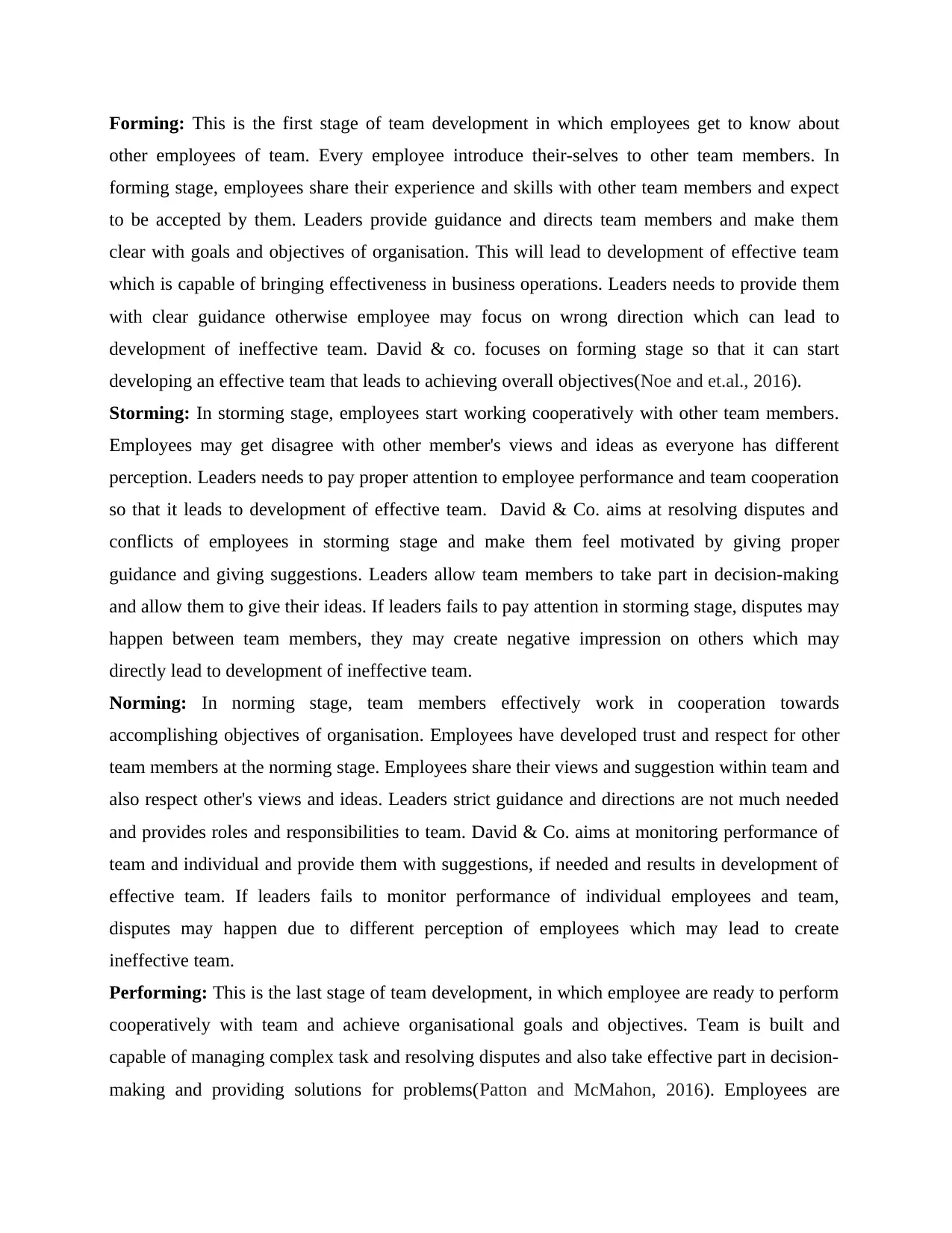
Forming: This is the first stage of team development in which employees get to know about
other employees of team. Every employee introduce their-selves to other team members. In
forming stage, employees share their experience and skills with other team members and expect
to be accepted by them. Leaders provide guidance and directs team members and make them
clear with goals and objectives of organisation. This will lead to development of effective team
which is capable of bringing effectiveness in business operations. Leaders needs to provide them
with clear guidance otherwise employee may focus on wrong direction which can lead to
development of ineffective team. David & co. focuses on forming stage so that it can start
developing an effective team that leads to achieving overall objectives(Noe and et.al., 2016).
Storming: In storming stage, employees start working cooperatively with other team members.
Employees may get disagree with other member's views and ideas as everyone has different
perception. Leaders needs to pay proper attention to employee performance and team cooperation
so that it leads to development of effective team. David & Co. aims at resolving disputes and
conflicts of employees in storming stage and make them feel motivated by giving proper
guidance and giving suggestions. Leaders allow team members to take part in decision-making
and allow them to give their ideas. If leaders fails to pay attention in storming stage, disputes may
happen between team members, they may create negative impression on others which may
directly lead to development of ineffective team.
Norming: In norming stage, team members effectively work in cooperation towards
accomplishing objectives of organisation. Employees have developed trust and respect for other
team members at the norming stage. Employees share their views and suggestion within team and
also respect other's views and ideas. Leaders strict guidance and directions are not much needed
and provides roles and responsibilities to team. David & Co. aims at monitoring performance of
team and individual and provide them with suggestions, if needed and results in development of
effective team. If leaders fails to monitor performance of individual employees and team,
disputes may happen due to different perception of employees which may lead to create
ineffective team.
Performing: This is the last stage of team development, in which employee are ready to perform
cooperatively with team and achieve organisational goals and objectives. Team is built and
capable of managing complex task and resolving disputes and also take effective part in decision-
making and providing solutions for problems(Patton and McMahon, 2016). Employees are
other employees of team. Every employee introduce their-selves to other team members. In
forming stage, employees share their experience and skills with other team members and expect
to be accepted by them. Leaders provide guidance and directs team members and make them
clear with goals and objectives of organisation. This will lead to development of effective team
which is capable of bringing effectiveness in business operations. Leaders needs to provide them
with clear guidance otherwise employee may focus on wrong direction which can lead to
development of ineffective team. David & co. focuses on forming stage so that it can start
developing an effective team that leads to achieving overall objectives(Noe and et.al., 2016).
Storming: In storming stage, employees start working cooperatively with other team members.
Employees may get disagree with other member's views and ideas as everyone has different
perception. Leaders needs to pay proper attention to employee performance and team cooperation
so that it leads to development of effective team. David & Co. aims at resolving disputes and
conflicts of employees in storming stage and make them feel motivated by giving proper
guidance and giving suggestions. Leaders allow team members to take part in decision-making
and allow them to give their ideas. If leaders fails to pay attention in storming stage, disputes may
happen between team members, they may create negative impression on others which may
directly lead to development of ineffective team.
Norming: In norming stage, team members effectively work in cooperation towards
accomplishing objectives of organisation. Employees have developed trust and respect for other
team members at the norming stage. Employees share their views and suggestion within team and
also respect other's views and ideas. Leaders strict guidance and directions are not much needed
and provides roles and responsibilities to team. David & Co. aims at monitoring performance of
team and individual and provide them with suggestions, if needed and results in development of
effective team. If leaders fails to monitor performance of individual employees and team,
disputes may happen due to different perception of employees which may lead to create
ineffective team.
Performing: This is the last stage of team development, in which employee are ready to perform
cooperatively with team and achieve organisational goals and objectives. Team is built and
capable of managing complex task and resolving disputes and also take effective part in decision-
making and providing solutions for problems(Patton and McMahon, 2016). Employees are
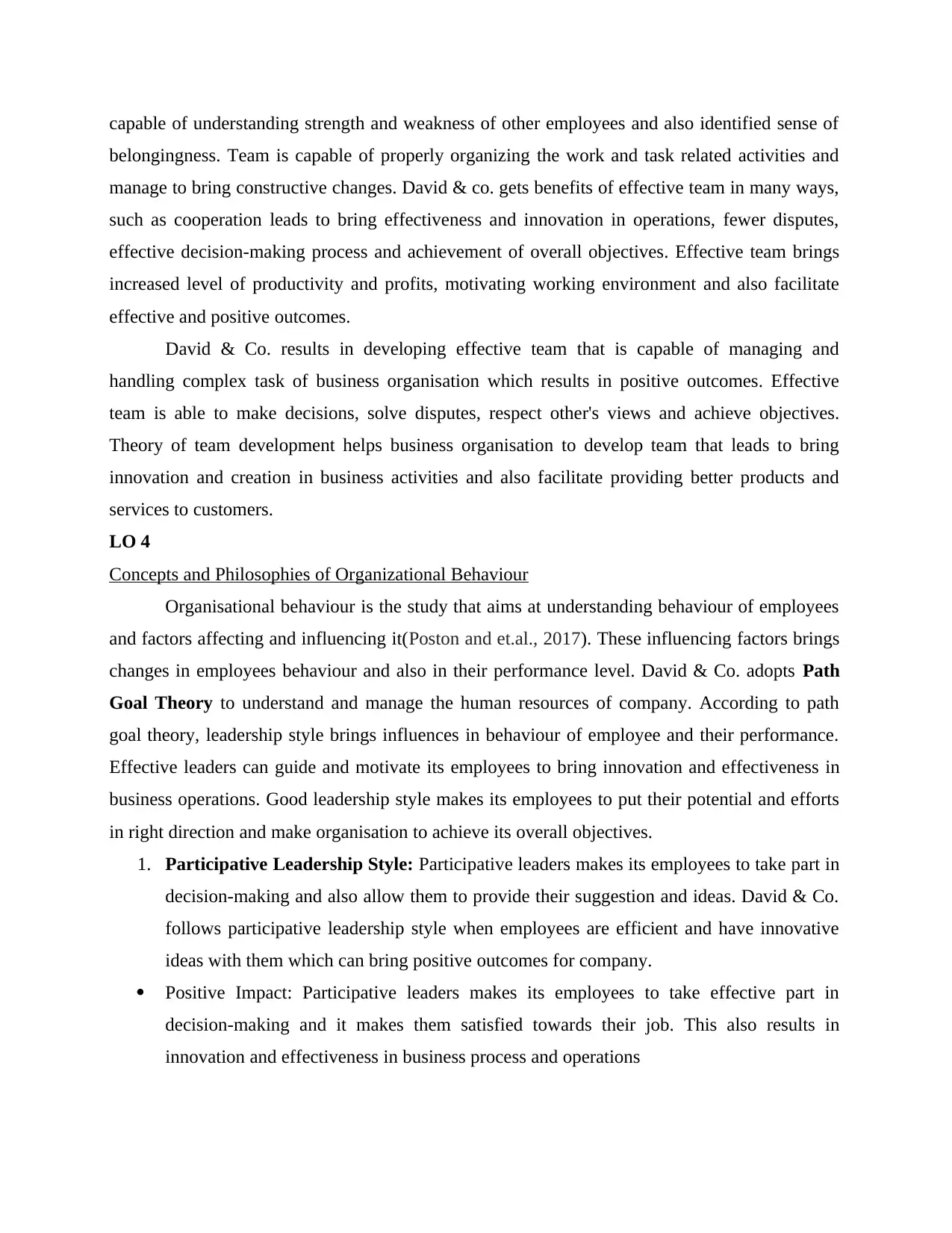
capable of understanding strength and weakness of other employees and also identified sense of
belongingness. Team is capable of properly organizing the work and task related activities and
manage to bring constructive changes. David & co. gets benefits of effective team in many ways,
such as cooperation leads to bring effectiveness and innovation in operations, fewer disputes,
effective decision-making process and achievement of overall objectives. Effective team brings
increased level of productivity and profits, motivating working environment and also facilitate
effective and positive outcomes.
David & Co. results in developing effective team that is capable of managing and
handling complex task of business organisation which results in positive outcomes. Effective
team is able to make decisions, solve disputes, respect other's views and achieve objectives.
Theory of team development helps business organisation to develop team that leads to bring
innovation and creation in business activities and also facilitate providing better products and
services to customers.
LO 4
Concepts and Philosophies of Organizational Behaviour
Organisational behaviour is the study that aims at understanding behaviour of employees
and factors affecting and influencing it(Poston and et.al., 2017). These influencing factors brings
changes in employees behaviour and also in their performance level. David & Co. adopts Path
Goal Theory to understand and manage the human resources of company. According to path
goal theory, leadership style brings influences in behaviour of employee and their performance.
Effective leaders can guide and motivate its employees to bring innovation and effectiveness in
business operations. Good leadership style makes its employees to put their potential and efforts
in right direction and make organisation to achieve its overall objectives.
1. Participative Leadership Style: Participative leaders makes its employees to take part in
decision-making and also allow them to provide their suggestion and ideas. David & Co.
follows participative leadership style when employees are efficient and have innovative
ideas with them which can bring positive outcomes for company.
Positive Impact: Participative leaders makes its employees to take effective part in
decision-making and it makes them satisfied towards their job. This also results in
innovation and effectiveness in business process and operations
belongingness. Team is capable of properly organizing the work and task related activities and
manage to bring constructive changes. David & co. gets benefits of effective team in many ways,
such as cooperation leads to bring effectiveness and innovation in operations, fewer disputes,
effective decision-making process and achievement of overall objectives. Effective team brings
increased level of productivity and profits, motivating working environment and also facilitate
effective and positive outcomes.
David & Co. results in developing effective team that is capable of managing and
handling complex task of business organisation which results in positive outcomes. Effective
team is able to make decisions, solve disputes, respect other's views and achieve objectives.
Theory of team development helps business organisation to develop team that leads to bring
innovation and creation in business activities and also facilitate providing better products and
services to customers.
LO 4
Concepts and Philosophies of Organizational Behaviour
Organisational behaviour is the study that aims at understanding behaviour of employees
and factors affecting and influencing it(Poston and et.al., 2017). These influencing factors brings
changes in employees behaviour and also in their performance level. David & Co. adopts Path
Goal Theory to understand and manage the human resources of company. According to path
goal theory, leadership style brings influences in behaviour of employee and their performance.
Effective leaders can guide and motivate its employees to bring innovation and effectiveness in
business operations. Good leadership style makes its employees to put their potential and efforts
in right direction and make organisation to achieve its overall objectives.
1. Participative Leadership Style: Participative leaders makes its employees to take part in
decision-making and also allow them to provide their suggestion and ideas. David & Co.
follows participative leadership style when employees are efficient and have innovative
ideas with them which can bring positive outcomes for company.
Positive Impact: Participative leaders makes its employees to take effective part in
decision-making and it makes them satisfied towards their job. This also results in
innovation and effectiveness in business process and operations
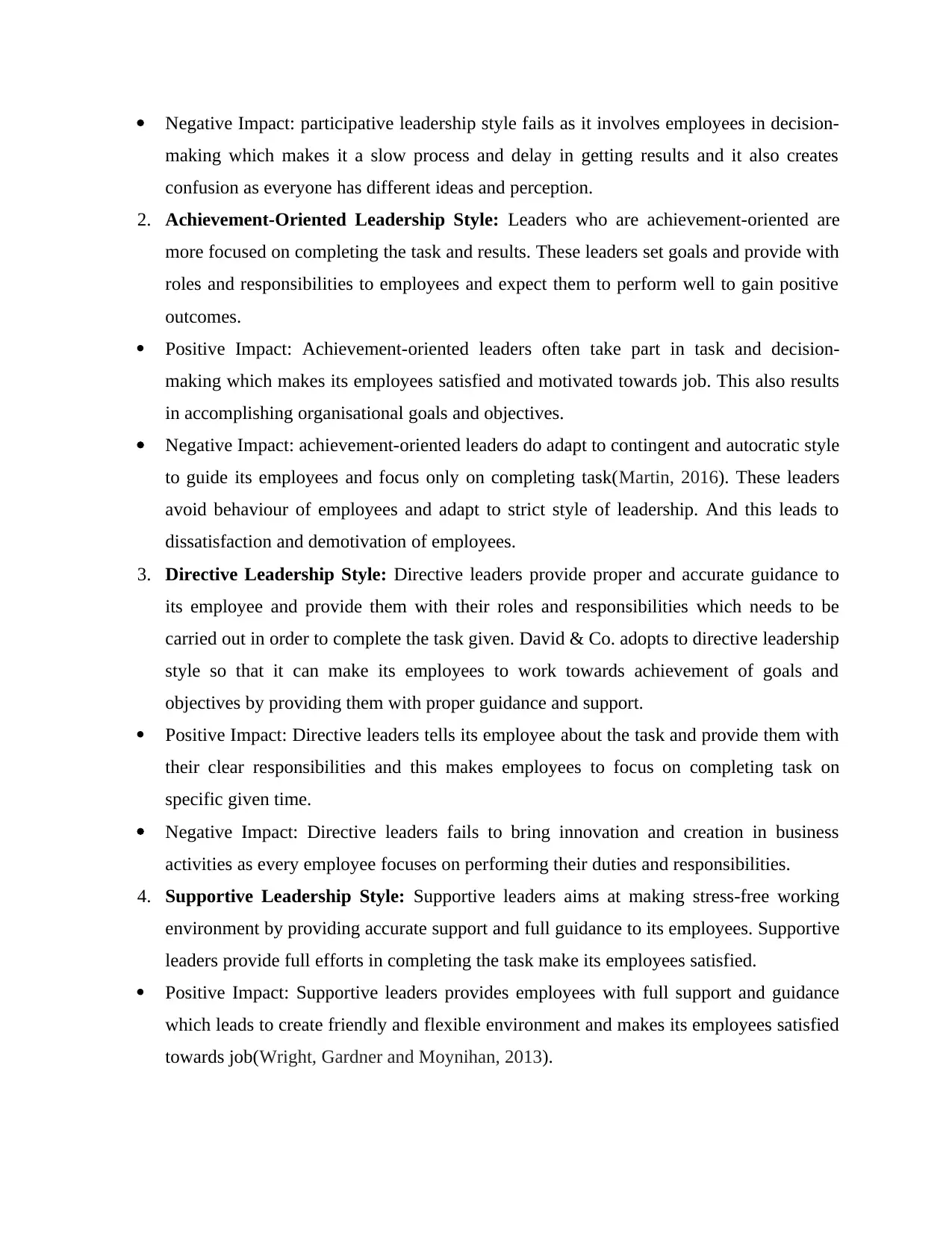
Negative Impact: participative leadership style fails as it involves employees in decision-
making which makes it a slow process and delay in getting results and it also creates
confusion as everyone has different ideas and perception.
2. Achievement-Oriented Leadership Style: Leaders who are achievement-oriented are
more focused on completing the task and results. These leaders set goals and provide with
roles and responsibilities to employees and expect them to perform well to gain positive
outcomes.
Positive Impact: Achievement-oriented leaders often take part in task and decision-
making which makes its employees satisfied and motivated towards job. This also results
in accomplishing organisational goals and objectives.
Negative Impact: achievement-oriented leaders do adapt to contingent and autocratic style
to guide its employees and focus only on completing task(Martin, 2016). These leaders
avoid behaviour of employees and adapt to strict style of leadership. And this leads to
dissatisfaction and demotivation of employees.
3. Directive Leadership Style: Directive leaders provide proper and accurate guidance to
its employee and provide them with their roles and responsibilities which needs to be
carried out in order to complete the task given. David & Co. adopts to directive leadership
style so that it can make its employees to work towards achievement of goals and
objectives by providing them with proper guidance and support.
Positive Impact: Directive leaders tells its employee about the task and provide them with
their clear responsibilities and this makes employees to focus on completing task on
specific given time.
Negative Impact: Directive leaders fails to bring innovation and creation in business
activities as every employee focuses on performing their duties and responsibilities.
4. Supportive Leadership Style: Supportive leaders aims at making stress-free working
environment by providing accurate support and full guidance to its employees. Supportive
leaders provide full efforts in completing the task make its employees satisfied.
Positive Impact: Supportive leaders provides employees with full support and guidance
which leads to create friendly and flexible environment and makes its employees satisfied
towards job(Wright, Gardner and Moynihan, 2013).
making which makes it a slow process and delay in getting results and it also creates
confusion as everyone has different ideas and perception.
2. Achievement-Oriented Leadership Style: Leaders who are achievement-oriented are
more focused on completing the task and results. These leaders set goals and provide with
roles and responsibilities to employees and expect them to perform well to gain positive
outcomes.
Positive Impact: Achievement-oriented leaders often take part in task and decision-
making which makes its employees satisfied and motivated towards job. This also results
in accomplishing organisational goals and objectives.
Negative Impact: achievement-oriented leaders do adapt to contingent and autocratic style
to guide its employees and focus only on completing task(Martin, 2016). These leaders
avoid behaviour of employees and adapt to strict style of leadership. And this leads to
dissatisfaction and demotivation of employees.
3. Directive Leadership Style: Directive leaders provide proper and accurate guidance to
its employee and provide them with their roles and responsibilities which needs to be
carried out in order to complete the task given. David & Co. adopts to directive leadership
style so that it can make its employees to work towards achievement of goals and
objectives by providing them with proper guidance and support.
Positive Impact: Directive leaders tells its employee about the task and provide them with
their clear responsibilities and this makes employees to focus on completing task on
specific given time.
Negative Impact: Directive leaders fails to bring innovation and creation in business
activities as every employee focuses on performing their duties and responsibilities.
4. Supportive Leadership Style: Supportive leaders aims at making stress-free working
environment by providing accurate support and full guidance to its employees. Supportive
leaders provide full efforts in completing the task make its employees satisfied.
Positive Impact: Supportive leaders provides employees with full support and guidance
which leads to create friendly and flexible environment and makes its employees satisfied
towards job(Wright, Gardner and Moynihan, 2013).
Secure Best Marks with AI Grader
Need help grading? Try our AI Grader for instant feedback on your assignments.
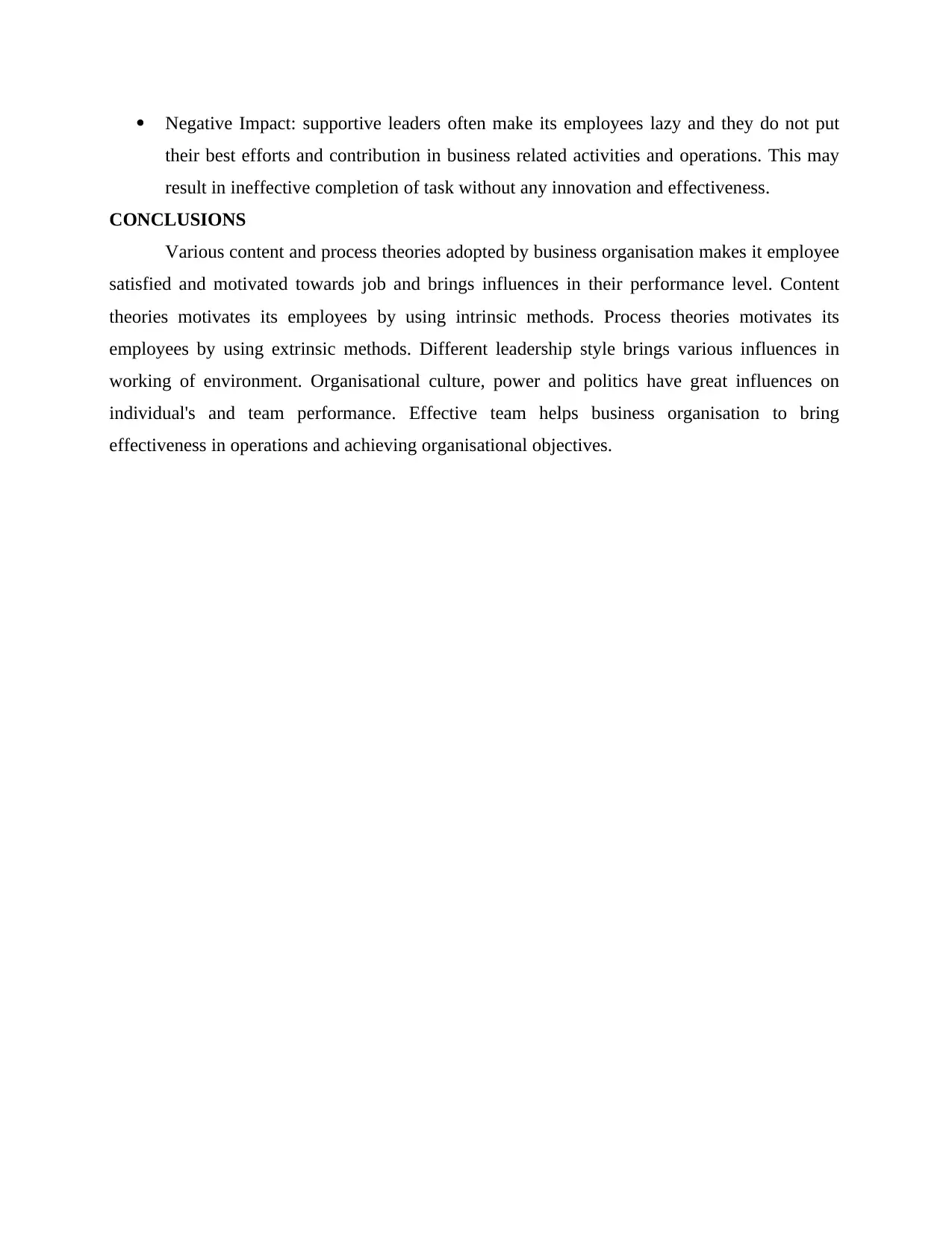
Negative Impact: supportive leaders often make its employees lazy and they do not put
their best efforts and contribution in business related activities and operations. This may
result in ineffective completion of task without any innovation and effectiveness.
CONCLUSIONS
Various content and process theories adopted by business organisation makes it employee
satisfied and motivated towards job and brings influences in their performance level. Content
theories motivates its employees by using intrinsic methods. Process theories motivates its
employees by using extrinsic methods. Different leadership style brings various influences in
working of environment. Organisational culture, power and politics have great influences on
individual's and team performance. Effective team helps business organisation to bring
effectiveness in operations and achieving organisational objectives.
their best efforts and contribution in business related activities and operations. This may
result in ineffective completion of task without any innovation and effectiveness.
CONCLUSIONS
Various content and process theories adopted by business organisation makes it employee
satisfied and motivated towards job and brings influences in their performance level. Content
theories motivates its employees by using intrinsic methods. Process theories motivates its
employees by using extrinsic methods. Different leadership style brings various influences in
working of environment. Organisational culture, power and politics have great influences on
individual's and team performance. Effective team helps business organisation to bring
effectiveness in operations and achieving organisational objectives.
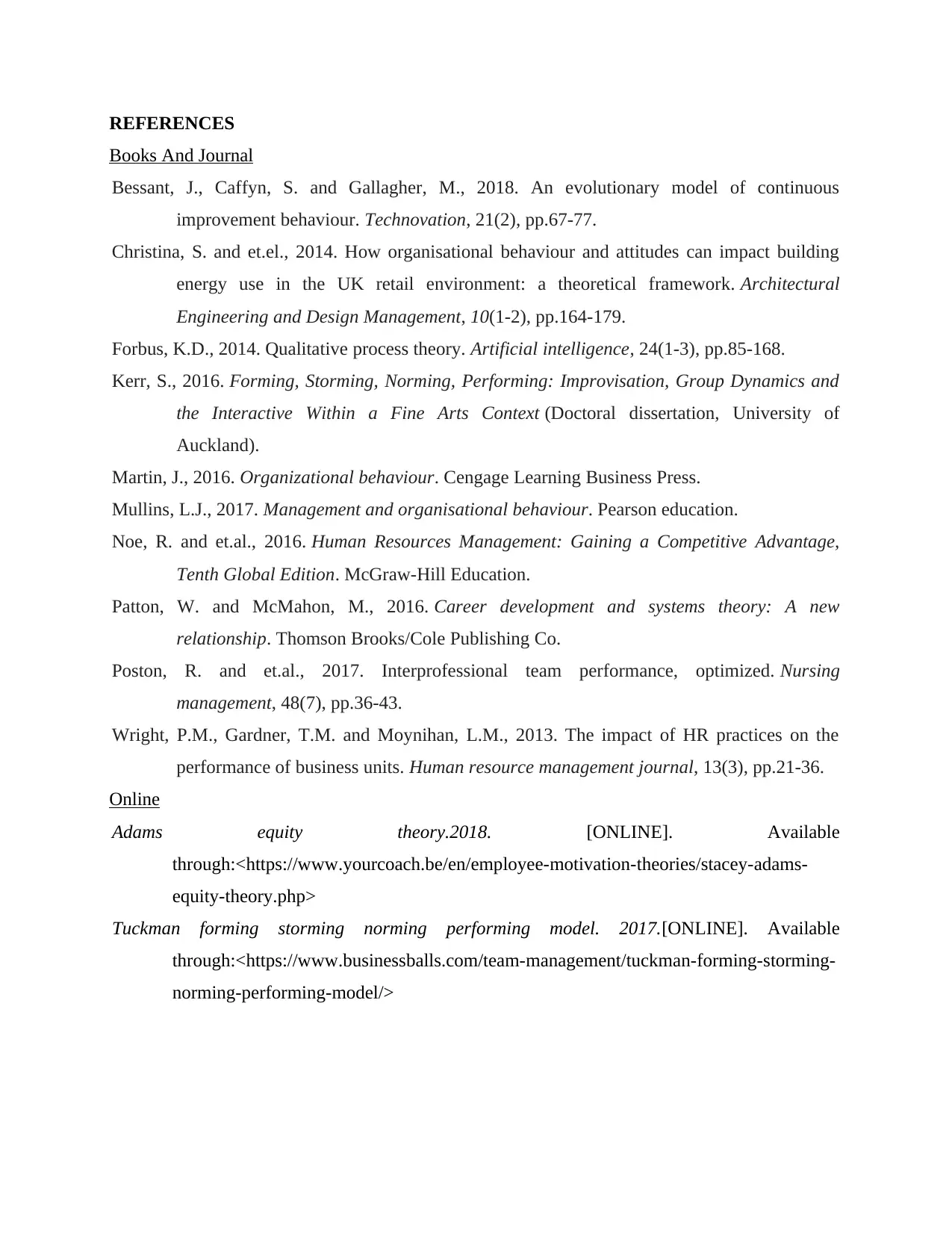
REFERENCES
Books And Journal
Bessant, J., Caffyn, S. and Gallagher, M., 2018. An evolutionary model of continuous
improvement behaviour. Technovation, 21(2), pp.67-77.
Christina, S. and et.el., 2014. How organisational behaviour and attitudes can impact building
energy use in the UK retail environment: a theoretical framework. Architectural
Engineering and Design Management, 10(1-2), pp.164-179.
Forbus, K.D., 2014. Qualitative process theory. Artificial intelligence, 24(1-3), pp.85-168.
Kerr, S., 2016. Forming, Storming, Norming, Performing: Improvisation, Group Dynamics and
the Interactive Within a Fine Arts Context (Doctoral dissertation, University of
Auckland).
Martin, J., 2016. Organizational behaviour. Cengage Learning Business Press.
Mullins, L.J., 2017. Management and organisational behaviour. Pearson education.
Noe, R. and et.al., 2016. Human Resources Management: Gaining a Competitive Advantage,
Tenth Global Edition. McGraw-Hill Education.
Patton, W. and McMahon, M., 2016. Career development and systems theory: A new
relationship. Thomson Brooks/Cole Publishing Co.
Poston, R. and et.al., 2017. Interprofessional team performance, optimized. Nursing
management, 48(7), pp.36-43.
Wright, P.M., Gardner, T.M. and Moynihan, L.M., 2013. The impact of HR practices on the
performance of business units. Human resource management journal, 13(3), pp.21-36.
Online
Adams equity theory.2018. [ONLINE]. Available
through:<https://www.yourcoach.be/en/employee-motivation-theories/stacey-adams-
equity-theory.php>
Tuckman forming storming norming performing model. 2017.[ONLINE]. Available
through:<https://www.businessballs.com/team-management/tuckman-forming-storming-
norming-performing-model/>
Books And Journal
Bessant, J., Caffyn, S. and Gallagher, M., 2018. An evolutionary model of continuous
improvement behaviour. Technovation, 21(2), pp.67-77.
Christina, S. and et.el., 2014. How organisational behaviour and attitudes can impact building
energy use in the UK retail environment: a theoretical framework. Architectural
Engineering and Design Management, 10(1-2), pp.164-179.
Forbus, K.D., 2014. Qualitative process theory. Artificial intelligence, 24(1-3), pp.85-168.
Kerr, S., 2016. Forming, Storming, Norming, Performing: Improvisation, Group Dynamics and
the Interactive Within a Fine Arts Context (Doctoral dissertation, University of
Auckland).
Martin, J., 2016. Organizational behaviour. Cengage Learning Business Press.
Mullins, L.J., 2017. Management and organisational behaviour. Pearson education.
Noe, R. and et.al., 2016. Human Resources Management: Gaining a Competitive Advantage,
Tenth Global Edition. McGraw-Hill Education.
Patton, W. and McMahon, M., 2016. Career development and systems theory: A new
relationship. Thomson Brooks/Cole Publishing Co.
Poston, R. and et.al., 2017. Interprofessional team performance, optimized. Nursing
management, 48(7), pp.36-43.
Wright, P.M., Gardner, T.M. and Moynihan, L.M., 2013. The impact of HR practices on the
performance of business units. Human resource management journal, 13(3), pp.21-36.
Online
Adams equity theory.2018. [ONLINE]. Available
through:<https://www.yourcoach.be/en/employee-motivation-theories/stacey-adams-
equity-theory.php>
Tuckman forming storming norming performing model. 2017.[ONLINE]. Available
through:<https://www.businessballs.com/team-management/tuckman-forming-storming-
norming-performing-model/>
1 out of 12
Related Documents
Your All-in-One AI-Powered Toolkit for Academic Success.
+13062052269
info@desklib.com
Available 24*7 on WhatsApp / Email
![[object Object]](/_next/static/media/star-bottom.7253800d.svg)
Unlock your academic potential
© 2024 | Zucol Services PVT LTD | All rights reserved.





